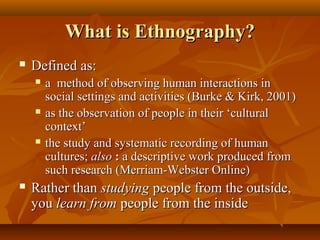Ethnography is defined as the observation and study of human cultures and involves learning from people by observing their behaviors and interactions in their natural social and cultural contexts. It was invented in 1915 by Bronislaw Malinowski who spent three years living with and observing the Trobriand Islands people of New Guinea, establishing the modern practice of ethnographic fieldwork. The key aspects of ethnography include preparing for and conducting field studies through observation and interviews, analyzing the collected data, and reporting the findings to provide insights into the people, activities, and cultures being studied.















